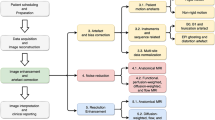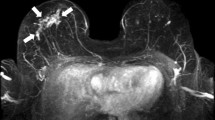Abstract
Purpose
Magnetic resonance imaging (MRI) is a frequently used system in medical imaging and disease interpretation. Most of the time, MRIs in humans show detailed tissue architecture. Low contrast in MRI images is a result of an unfavourable imaging environment. An image's contrast can be increased by employing the straightforward histogram equalization (HE) method. However, HE has numerous disadvantages that make it unsuitable for many applications, such as a significant change in brightness, artificial effects, and over-enhancement.
Methods
This method suggests a new adaptive heuristic HE technique to address these problems. The image's probability distribution function (PDF) is computed first. The maximum and average values of the PDF are used to create an adaptive parameter in the second step. The adaptive parameter is then limited by adding a threshold to the PDF and cumulative distribution function (CDF). Finally, a novel CDF is attained by employing another adaptive parameter discovered by applying the updated CDF. The enhanced image is obtained by combining the new CDF with conventional HE.
Results
The suggested method performs better visually and quantitatively than equated state-of-the-art techniques and is equally effective for low-contrast MRI images. The application of the proposed method was assessed and contrasted using the standard performance measures.
Conclusions
After considerable testing, it was discovered that the suggested method effectively increases visual contrast while retaining the original characteristics of the input photographs and avoiding overly or inadequately improved images.












Similar content being viewed by others
Availability of data and material (data transparency)
Not applicable.
Code availability (software application or custom code)
Not applicable.
References
Al-Galal SAY, Alshaikhli IFT, Abdulrazzaq MM. MRI brain tumor medical images analysis using deep learning techniques: a systematic review. Health Technol. 2021;11:267–82.
Sharma AK, Nandal A, Dhaka A, Dixit R. A survey on machine learning based brain retrieval algorithms in medical image analysis. Health Technol. 2020;10:1359–73.
Abd-Ellah MK, Awad AI, Khalaf AAM, Hamed HFA. A review on brain tumor diagnosis from MRI images: Practical implications, key achievements, and lessons learned. Magn Reson Imaging. 2019;61:300–18. https://doi.org/10.1016/J.MRI.2019.05.028.
Pandey SK, Bhandari AK, Singh H. A transfer learning based deep learning model to diagnose covid-19 CT scan images. Health Technol. 2022;12(4):845–66.
Kumar R, Bhandari AK. Spatial mutual information based detail preserving magnetic resonance image enhancement. Comput Biol Med. 2022;146: 105644. https://doi.org/10.1016/J.COMPBIOMED.2022.105644.
Gonzalez RC, Woods RE, Masters BR, Processing DI. Third Edition. J Biomed Opt. 2009;14(2): 029901. https://doi.org/10.1117/1.3115362.
Agrawal S, Panda R, Mishro PK, Abraham A. A novel joint histogram equalization based imagecontrast enhancement. J King Saud Univ Comp Information Sci. 2022;34(4):1172–82.
Mittal A, Moorthy AK, Bovik AC. Blind/referenceless image spatial quality evaluator. In conference record of the forty fifth asilomar conference on signals, systems and computers 2011;723–727. IEEE, Pacific Grove, CA, USA.
Gu K, Lin W, Zhai G, Yang X, Zhang W, Chen CW. No-reference quality metric of contrast-distorted images based on information maximization. IEEE Trans Cybern. 2017;47(12):4559–65. https://doi.org/10.1109/TCYB.2016.2575544.
Celik T. Spatial mutual information and pagerank-based contrast enhancement and quality-aware relative contrast measure. IEEE Trans Image Process. 2016;25(10):4719–28. https://doi.org/10.1109/TIP.2016.2599103.
Joseph J, Sivaraman J, Periyasamy R, Simi VR. An objective method to identify optimum clip-limit and histogram specification of contrast limited adaptive histogram equalization for MR images. Biocybern Biomed Eng. 2017;37(3):489–97. https://doi.org/10.1016/J.BBE.2016.11.006.
Wang S, Ma K, Yeganeh H, Wang Z, Lin W. A patch-structure representation method for quality assessment of contrast changed images. IEEE Signal Process Lett. 2015;22(12):2387–90. https://doi.org/10.1109/LSP.2015.2487369.
Wang S, Zheng J, Hu HM, Li B. Naturalness preserved enhancement algorithm for non-uniform illumination images. IEEE Trans Image Process. 2013;22(9):3538–48. https://doi.org/10.1109/TIP.2013.2261309.
Kim YT. Contrast enhancement using brightness preserving bi-histogram equalization. IEEE Trans Consum Electron. 1997;43(1):1–8. https://doi.org/10.1109/30.580378.
Chen SD, Ramli AR. Contrast enhancement using recursive mean-separate histogram equalization for scalable brightness preservation. IEEE Trans Consum Electron. 2003;49(4):1301–9. https://doi.org/10.1109/TCE.2003.1261233.
Wang Y, Chen Q, Zhang B. Image enhancement based on equal area dualistic sub-image histogram equalization method. IEEE Trans Consum Electron. 1999;45(1):68–75. https://doi.org/10.1109/30.754419.
Menotti D, Najman L, Facon J, de Araújo A. Multi-histogram equalization methods for contrast enhancement and brightness preserving. IEEE Trans Consum Electron. 2007;53(3):1186–94. https://doi.org/10.1109/TCE.2007.4341603.
Huang SC, Cheng FC, Chiu YS. Efficient contrast enhancement using adaptive gamma correction with weighting distribution. IEEE Trans Image Process. 2013;22(3):1032–41. https://doi.org/10.1109/TIP.2012.2226047.
Tiwari M, Gupta B, Shrivastava M. High-speed quantile-based histogram equalization for brightness preservation and contrast enhancement. IET Image Process. 2015;9(1):80–9. https://doi.org/10.1049/IET-IPR.2013.0778.
Ling Z, Liang Y, Wang Y, Shen H, Lu X. Adaptive extended piecewise histogram equalization for dark image enhancement. IET Image Process. 2015;9(11):1012–9. https://doi.org/10.1049/IET-IPR.2014.0580.
Wang X, Chen L. An effective histogram modification scheme for image contrast enhancement. Signal Process Image Commun. 2017;58:187–98. https://doi.org/10.1016/J.IMAGE.2017.07.009.
Paul A, Bhattacharya P, Maity SP, Bhattacharyya BK. Plateau limit-based tri-histogram equalisation for image enhancement. IET Image Process. 2018;12(9):1617–25. https://doi.org/10.1049/IET-IPR.2017.1088.
Suvarna Kumar G, Reddy P, Gupta S, Kumar RA. Heuristic-based face recognition using image processing techniques. Int J Comput Appl. 2011;34(6):975–8887.
Rao BS. Dynamic histogram equalization for contrast enhancement for digital images. Appl Soft Comput. 2020;89:106114.
Zhao G, et al. HS–GS: a method for multicenter MR image standardization. IEEE Access. 2020;8:158512–22.
Acharya UK, Kumar S. Genetic algorithm based adaptive histogram equalization (GAAHE) technique for medical image enhancement. Optik (Stuttg). 2021;230:166273.
He K, Gong J, Xie L, Zhang X, Xu D. Regions preserving edge enhancement for multisensor-based medical image fusion. IEEE Trans Instrum Meas. 2021;70:1–13.
Naseem R, Khan ZA, Satpute N, Beghdadi A, Cheikh FA, Olivares J. Cross-modality guided contrast enhancement for improved liver tumor image segmentation. IEEE Access. 2021;9:118154–67.
Acharya UK, Kumar S. Particle swarm optimized texture based histogram equalization (PSOTHE) for MRI brain image enhancement. Optik (Stuttg). 2020;224: 165760.
Ooi CH, Isa NAM. Quadrants dynamic histogram equalization for contrast enhancement. IEEE Trans Consum Electron. 2010;56(4):2552–9. https://doi.org/10.1109/TCE.2010.5681140.
Fu X, Liao Y, Zeng D, Huang Y, Zhang XP, Ding X. A probabilistic method for image enhancement with simultaneous illumination and reflectance estimation. IEEE Trans Image Process. 2015;24(12):4965–77. https://doi.org/10.1109/TIP.2015.2474701.
Gu K, Zhai G, Lin W, Liu M. The analysis of image contrast: from quality assessment to automatic enhancement. IEEE Trans Cybern. 2016;46(1):284–97. https://doi.org/10.1109/TCYB.2015.2401732.
Parihar AS, Verma OP, Khanna C. Fuzzy-contextual contrast Enhancement. IEEE Trans Image Process. 2017;26(4):1810–9. https://doi.org/10.1109/TIP.2017.2665975.
Bhandari AK, Shahnawazuddin S, Meena AK. A Novel Fuzzy Clustering-Based Histogram Model for Image Contrast Enhancement. IEEE Trans Fuzzy Syst. 2020;28(9):2009–21. https://doi.org/10.1109/TFUZZ.2019.2930028.
Bhandari AK, Kandhway P, Maurya S. Salp swarm algorithm-based optimally weighted histogram framework for image enhancement. IEEE Trans Instrum Meas. 2020;69(9):6807–15. https://doi.org/10.1109/TIM.2020.2976279.
Bhandari AK, Srinivas K, Kumar A. Optimized histogram computation model using cuckoo search for color image contrast distortion. Digit Signal Process. 2021;118:103203. https://doi.org/10.1016/J.DSP.2021.103203
Acknowledgements
The authors would like to express their gratitude to Dr. Rajnath Singh, Senior Resident, Shri Krishna Medical College and Hospital, Muzaffarpur, Bihar, India, and Dr. Md. Sabit Hussain, Eye Hospital and Research Centre, Motihari, Bihar for their valuable suggestions, guidance and support towards various medical issues related to this proposed method which all are based on their real experiences during their duty in ICUs and wards.
Funding
The authors did not receive support from any organization for the submitted work. No funding was received to assist with the preparation of this manuscript. No funding was received for conducting this study. No funds, grants, or other support was received.
Author information
Authors and Affiliations
Contributions
All authors contributed to the study conception and design. Material preparation, data collection and analysis were performed by Ravi Kumar and Ashish Kumar Bhandari. The first draft of the manuscript was written by Ravi Kumar and all authors commented on previous versions of the manuscript. All authors read and approved the final manuscript.
Corresponding author
Ethics declarations
Ethical approval
This article does not contain any studies with human participants or animals performed by any of the authors.
Informed consent
Not applicable.
Research involving human and animal participants
Not applicable.
Conflicts of interest
The authors report no conflict of interest.
Additional information
Publisher’s Note
Springer Nature remains neutral with regard to jurisdictional claims in published maps and institutional affiliations.
Rights and permissions
Springer Nature or its licensor (e.g. a society or other partner) holds exclusive rights to this article under a publishing agreement with the author(s) or other rightsholder(s); author self-archiving of the accepted manuscript version of this article is solely governed by the terms of such publishing agreement and applicable law.
About this article
Cite this article
Kumar, R., Bhandari, A.K. Visibility enhancement of brain tumor affected MRI images using adaptive heuristic process. Health Technol. (2024). https://doi.org/10.1007/s12553-024-00834-x
Received:
Accepted:
Published:
DOI: https://doi.org/10.1007/s12553-024-00834-x




